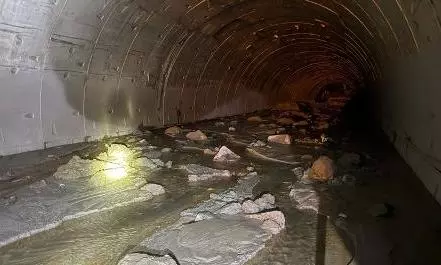SLBC tunnel rescue operation turning India’s longest ever
When rescue operations began in earnest four days after the February 22 accident there were some hopes that some of the eight missing workers may be found alive, everyone involved soon realised that it would be more of a recovery, than a rescue operation.

Hyderabad: The ongoing operation inside the SLBC tunnel in Nagarkurnool district, which entered its 35th day on Saturday, has emerged as the most complex and challenging tunnel rescue or recovery operation in India.
Officials later estimated after the first recce of the disaster site at the 13.9 km point inside the tunnel was managed on February 26 - four days after the accident – that around 25,000 tonnes of rock and silt collapsed into the tunnel, burying the 1,500-tonne TBM, breaking parts of it and pushing them back by around 100 metres, even as water at the rate of 3,500 litres per minute was pouring in from the huge cavity that formed at the collapse site.
When rescue operations began in earnest four days after the February 22 accident there were some hopes that some of the eight missing workers may be found alive, everyone involved soon realised that it would be more of a recovery, than a rescue operation.
“I don’t think there has ever been such an incident where a TBM was being used and so much muck entered a tunnel,” Col Parikshit Mehra, who led the Silkiyara tunnel rescue in Uttarakhand in which 41 workers were rescued alive, from the Border Roads Organisation, said.
After 35 days and counting, the SLBC operations, still officially a rescue mission, has become the longest such exercise ever in India. The longest earlier rescue operation was in November 2023 at the Silkyara tunnel. This lasted 17 days ending in successful rescue of all 41 workers who were trapped behind a 47 metres thick wall of fallen rocks just around one km from the tunnel opening.
“Even a recce in the SLBC tunnel was a complex task. The tunnel locomotive could only go 11.5 km beyond which water level was rising. The conditions were life-threatening, walking in the muck meant one could sink. The only option was to clamber on to the conveyor belt, and move forward. And since the ventilation shaft was broken there was no fresh air in the last 500 metres and there were no lights,” he said.
Even when work began, rescuers had to watch every step to stay safe from steel parts buried in the silt, contend with the possibility of fresh rock falls or sudden gush of water, and return back a few hundred metres after every 10 or 15 minutes of work to catch their breath.
As the ventilation shaft was destroyed, a series of pedestal fans were placed on the accumulated silt to “push” fresh air in the work area. It was only after around 10 days that after repairs to the shaft that ventilation improved.
“Somewhere in the middle of the mountain, there was a lot of muck, almost an underground river that got punctured. That explains the amount of muck that fell down. This left a huge cavity on top and right side of the collapse site which is around 30 metres high and 25 metres wide. On the left side was a chute-like pipe within the hill side,” Col. Mehra, who was the first to reach the collapse point, and had to crawl on his belly to that point, said.
Officials supervising the ongoing work inside the tunnel, said the present goal is to clean up all the silt and rocks, and any parts of the TBM leaving the last 30 metres of the collapse zone that has been declared as a prohibited zone because of a very serious possibility that moving any of the muck that covers the rest of the buried TBM in that section, might trigger another collapse.
The officials have set an April 10 deadline to complete the clean up till the 30-metre no go zone. While they hope that they can find bodies of the rest of the still missing six workers, if this does not happen, then the officials, before calling off, or pausing the search, want to be certain that everything that was humanly possible was done in the search.
Important Points
SLBC tunnel collapse
February 22
8.15 am: Collapse begins.
8 workers trapped, 42 moved to safety.
9 am: 25,000 tonnes of rock and silt fall into tunnel.
For first three days, muck makes it impossible for anyone to go in.
1,500-tonne tunnel boring machine broken, parts weighing hundreds of tonnes pushed back some 100 metres.
634 personnel from 27 agencies, including NDRF, SDRF, SCCL, Army, Navy, railways, NDMA, NGRI, GSI, Kerala police, rat miners, Navayuga, L&T and Solinas, IIT-Madras, involved in rescue operation.
Fresh air still a challenge, four diesel powered excavators working to remove silt.
Around 50 lakh litres of water a day still pouring in
